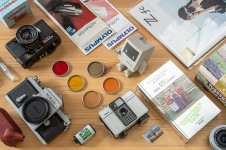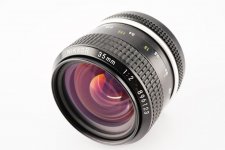p.giannakis
Pan Giannakis
Bought an Olympus OM-2n, with what I thought was a standard 50/1.8 Zuiko, but instead this was on the body together with a Teleplus 2X. It was a bit of a chock!
The gods of mount Olympus have been very kind to you.
Capt. E
Established
The last purchase is a Nikon S2 black dial body in original black paint, near mint condition. Rather rare, but I paid less than $700. Or should I say I stole it? Perhaps. I put a black Nikkor 5cm f1.4 on it. Quite appropriate. It is BEAUTIFUL!
JeffS7444
Well-known
Bunch of recent-ish acquisitions, some previously shared.
Nikon F is film-ready.
Konica S3 is mostly ready, but it needs a new cds photocell. I'll order it with my next electronic parts order.
Ricoh Auto Half has a dead selenium photocell. I'll try replacing it with a modern silicon photocell, but output of the modern part is much higher, so adjustments will be needed.
Olympus 14-42EZ zoom is a decent, small and inexpensive M43 lens. Not much bokeh to be had, but for casual shooting, it's more than okay.
No idea why my mom saved brochures for a camera that's long gone, but now they're part of my collection.
I don't currently own a Nikin Zfc, and it wouldn't fill any particular niche for me except as retro-styled boutique item, not that there's anything wrong with that. It seems that Japan still gets lavish product brochures.
I retrieved the Kodak Wratten Series VI filters at the same time as the Olympus brochures. They'll fit my mom's old Rolleicord.
Classicbot Classic ordered directly from https://classicbot.com/

Nikon F is film-ready.
Konica S3 is mostly ready, but it needs a new cds photocell. I'll order it with my next electronic parts order.
Ricoh Auto Half has a dead selenium photocell. I'll try replacing it with a modern silicon photocell, but output of the modern part is much higher, so adjustments will be needed.
Olympus 14-42EZ zoom is a decent, small and inexpensive M43 lens. Not much bokeh to be had, but for casual shooting, it's more than okay.
No idea why my mom saved brochures for a camera that's long gone, but now they're part of my collection.
I don't currently own a Nikin Zfc, and it wouldn't fill any particular niche for me except as retro-styled boutique item, not that there's anything wrong with that. It seems that Japan still gets lavish product brochures.
I retrieved the Kodak Wratten Series VI filters at the same time as the Olympus brochures. They'll fit my mom's old Rolleicord.
Classicbot Classic ordered directly from https://classicbot.com/

p.giannakis
Pan Giannakis
Evergreen States
Pierre Saget (they/them)
Snagged a Minolta Autocord from Karl Bryan. Has a nice roll of HP5+ in it that I'm rating at ISO 200
lxmike
M2 fan.
10 rolls of hp5 120 
flavio81
Well-known
The W-Nikkor 35/2.5 on my Nikonos V has produced spectacular results. Definitely a very sharp lens.
I just got mine today from the mail. My W-Nikkor 35/2.5 (chrome version) is in stunningly good shape, optically.
Now let's see what it can do.
seany65
Well-known
This is the important bit ""R6x Red Filter Factor 6-8"." and it means 6 to 8 stops adjustment to the exposure. You'll have to experiment to see how it works with your standards B&W film, assuming you have one or even a choice these days.
As for "R3" it probably identifies the filter in their (Animex's) range; so we can guess there's a R1 and R2 and even R4...
Regards, David
David, Thanks for the reply. But are you sure it's 6 to 8 stops and not 2&1/2 to 3 stops, as a filter factor of 8 usually means 3 stops. Remembering this, and that a filter factor of 4x usually means 2 stops, I was presuming that R6x means 2&1/2 stops.
I'm sure you're right about there being R1's and R2's etc.
I've just had a brainwave, (which, as it didn't break anything or cost me money is even more rare than my ordinary brainwaves.
I bought a Photax B30 Green filter from ebay, which has turned out to be just the sort of shade I wanted, instead of that pale, wishy-washy effect Green of the Rollei filters.
shawn
Mentor
SMC Pentax-FA 645 75mm F2.8, looking forward to it on the Pentax 645N.
Shawn
Shawn
Dan Grisez
Member
Bought... Paper Shoot Camera. Looked like cheap fun...and it is! https://papershootcamera.com/ Got the Vintage 1925 case.
Given to me... Rollei 35! Mint condition other than the slow shutter speeds sticking a bit. Can't wait to put it through its paces. Came with the original soft case, too.
Given to me... Rollei 35! Mint condition other than the slow shutter speeds sticking a bit. Can't wait to put it through its paces. Came with the original soft case, too.
Pál_K
Cameras. I has it.
…
Given to me... Rollei 35! Mint condition other than the slow shutter speeds sticking a bit. Can't wait to put it through its paces. Came with the original soft case, too.
Nice gift!
Does anyone know who is good at servicing the Rollei 35’s?
ChrisPlatt
Thread Killer
David Hughes
David Hughes
David, Thanks for the reply. But are you sure it's 6 to 8 stops and not 2&1/2 to 3 stops, as a filter factor of 8 usually means 3 stops. Remembering this, and that a filter factor of 4x usually means 2 stops, I was presuming that R6x means 2&1/2 stops.
I'm sure you're right about there being R1's and R2's etc.
The problem is that you never quite know what they mean and often you can get to rational but opposed meanings from the descriptions.
So trial and error is the answer but expensive. OR, collect old brochures and old instruction leaflets. Often they are written by different people and that further confuses the issue. Brochures tell you things are simply wonderful, instructions are simply confusing _sometimes_ but not always. I guess one of them is written by a committee and the other by a copywriter.
And then you run up against the problem that film speeds have been reassessed over time and the colour response of film has changed too. It's all good clean and harmless fun.
Regards, David
davidswiss
Established
A Contarex Professional. Not collected it yet, will pick up next Tuesday.
Except when I went to collect it was a Special, not a professional, and I couldn't get on with the waist level finder. Does anyone know if eye level finders ever made for the special ?
seany65
Well-known
The problem is that you never quite know what they mean and often you can get to rational but opposed meanings from the descriptions.
So trial and error is the answer but expensive. OR, collect old brochures and old instruction leaflets. Often they are written by different people and that further confuses the issue. Brochures tell you things are simply wonderful, instructions are simply confusing _sometimes_ but not always. I guess one of them is written by a committee and the other by a copywriter.
And then you run up against the problem that film speeds have been reassessed over time and the colour response of film has changed too. It's all good clean and harmless fun.
Regards, David
It may be good, clean and harmless fun to members like you who have several braincells, but what about those of us who have less than two?
Pál_K
Cameras. I has it.
It’s common for red filters to have a +3 stop adjustment, so I wouldn’t expect this filter to differ much. The 2.5 to 3 stops mentioned reflects what may need to be adjusted based on trial-and-error experience (as mentioned above) related to the film you’re using (its latitude and how it’s developed) plus your subject matter. Given all that, I think it’s much better to overexpose B&W a bit (the +3 stops rather than +2.5) than underexpose it.
dexdog
Mentor
A 1950 5cm, f1.5 ZK lens in Contax/Kiev mount. It is a beauty, and works well with my Sony 7aII and Nikon Z6. I figured I should get one in Contax mount to go along with the LTM version.
boojum
Mentor
A 1950 5cm, f1.5 ZK lens in Contax/Kiev mount. It is a beauty, and works well with my Sony 7aII and Nikon Z6. I figured I should get one in Contax mount to go along with the LTM version.
Those old Contax lenses sing a siren's song. Hard to resist, especially if you have any fondness for the vintage lenses.
Share:
-
This site uses cookies to help personalise content, tailor your experience and to keep you logged in if you register.
By continuing to use this site, you are consenting to our use of cookies.


